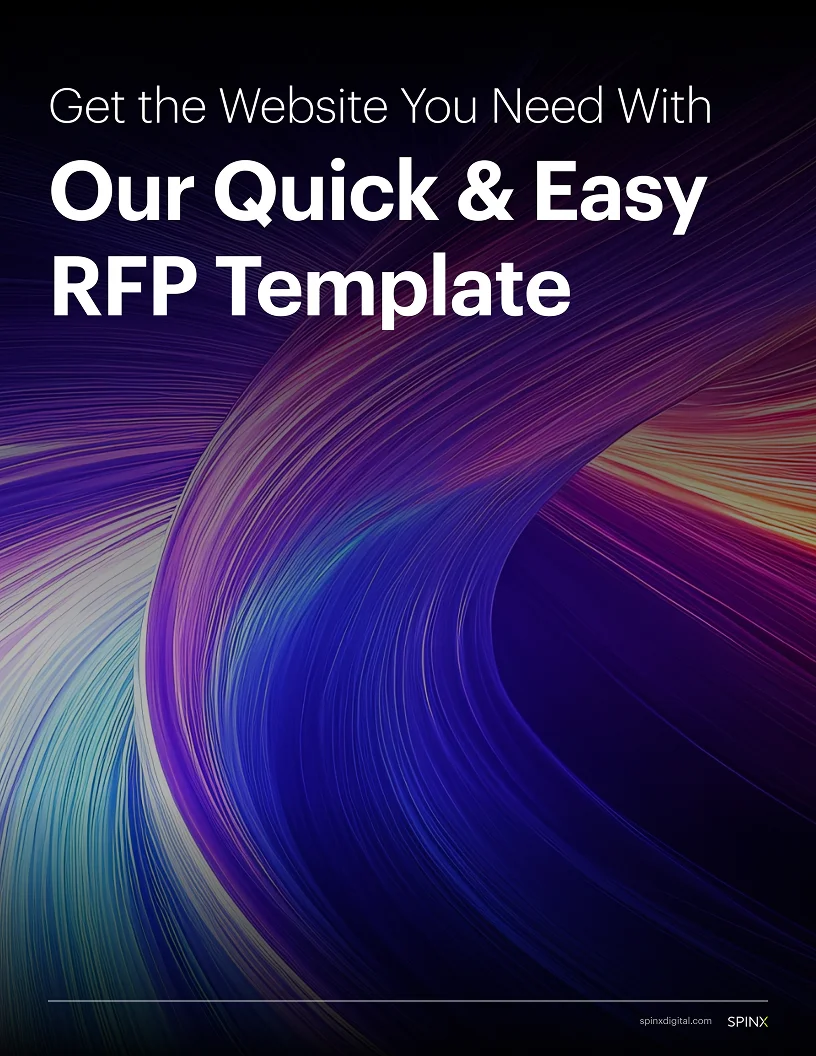Request For Proposal
Creating a Request For Proposal (RFP): A Guide to Attracting the Best Agency for Your Project
The next time you’re looking for an agency partner to collaborate on a web design project, one of the most important tools you’ll use is a Request for Proposal.
Table of Contents
What is a Request for Proposal?
A Request for Proposal (RFP) is a formal document that an organization shares with vendors to invite them to submit proposals for a specific project or service. The RFP typically outlines project requirements, expectations and evaluation criteria, and serves as a blueprint for vendors to craft their bids. An RFP helps organizations compare vendors and proposals in a systematic way, ensuring they select the best-fitting candidate for the job. It’s a crucial tool for organizations seeking transparency, clarity, and strategic alignment in the procurement process. It’s particularly helpful when hiring a partner for complex projects, as it helps you outline a variety of goals and granular requirements in an organized way. Finding the right partner to help you strategize and build your next web project can be tricky. But one thing is for sure: a well written Request for Proposal document can really help you find the right team.
Is Writing an RFP a Requirement?
Our Los Angeles website design agency is here to transform your digital space into an immersive journey. Reach out today and let's craft an online platform that leaves a lasting impression.

Benefits of Writing an RFP
There are a number of benefits to writing a thoughtful Request for Proposal (or RFP). One of the most important things is that it helps you accurately outline the challenges your team hopes to address and the goals you hope to achieve with the design project.
It Helps You Think Holistically About Your Website’s Role
Writing your RFP should be a team project, in which key stakeholders participate to clarify what they expect from the new website. This process of gathering and organizing information in collaboration with your team, encourages you to think holistically about the specific ways your new website can help your entire organization. Whether it’s to better tell your brand story, increase online lead generation and grow sales, or simplify workflow and marketing tasks, outlining all the specific goals for the new site, and the important interest of key stakeholders, will help agencies put their best ideas forward.
It Standardizes The Information Shared When Reaching Out To Website Agencies
One of the great things about an RFP, is that the document standardizes the information you’re sharing with all the agencies you reach out to. Everybody you speak to should be on the same page with a clear understanding of your goals and challenges. This way, they can put their best foot (and best solutions) forward. This helps you compare apples to apples when you’re looking at project recommendations and budget. You want to make sure some vendors don’t offer you a go cart, while others suggest an F1 race car. They may both have four wheels, but they have vastly different capabilities and price tags, and one of them is not likely to be a good solution for your needs.
It Shows You’re A Good Partner For Website Agencies
In our experience of working with hundreds of organizations, we’ve seen good and bad RFPs. Unfortunately, poorly drafted RFPs can turn away the very agencies that could be the best fit for your project. Just like you, agencies are looking for good partners. If you’re organized and thoughtful, it will show. If your RFP is confusing or unclear or shows that your expectations are unrealistic, some agencies may take a pass on the project.
What Makes an RFP Strong?
It provides vendors with enough information to understand the project, allowing them to submit proposals that are realistic, relevant, and aligned with your needs. Here are the key elements of a strong RFP:
Clarity
Well-defined project goals, timelines, and budgets reduce misunderstandings and ensure everyone is on the same page.
Detailed Requirements
Include specific details about your project’s needs and any technical specifications, features and integrations you require. Outline whether your team will be providing some resources for collaboration and how you expect to work together.
Realistic Timelines
Setting achievable deadlines helps vendors plan accordingly and ensure the project stays on track.
Vendor Evaluation Criteria
Be clear about what you value in a vendor—whether it’s experience, creativity, cost-effectiveness, or the ability to deliver ongoing support.
Background Information
Provide some background on your organization and current web site (if any) and explain the main challenges and pain points that are driving the project.
- Be clear about how the new site will help you as well as the problems your new site should solve.
- Do you sell things online and need to increase conversions?
- Do you need to better define who you are in the marketplace?
- Are you looking for excellent mobile experience?
- Are there elements of your team’s workflow that you want
When Should You Prepare an RFP?
Give yourself time to draft your RFP. A large web development project can take months to complete. Some organizations hire an expert outside consultant to lead an RFP process, in order to bring additional expertise into the project. Finding the right agency may also take a month or two. Or three. That’s why it makes sense to put in extra effort in the beginning of the process to make sure it goes as smoothly as possible.
When Should I Put Together My Website Team Members?
Before you even begin the search, you’ll want to determine your team of decision makers and align on the important details of your web project. Collaborating with your team on a draft of an RFP is a great way to do this. It allows you to get buy-in from key stakeholders and agreement on the important project requirements. There are important decisions you’ll need to make about the website you want, and it helps to make some of those decisions before you begin your search for a partner.
What if I Don't Pick My Team Until After the RFP Process?
If your team is not aligned on the important factors, you could find yourself making changes to the project after you’ve hired an agency, and the “scope of work” and the budget and timeline could end up changing.
When Might it Not Make Sense to Create an RFP?
Now, of course agencies are there to help you make decisions as well. And there are some instances when skipping the RFP process might make sense. Especially if you already have a trusted vendor or if time constraints or the need for highly specialized expertise make competitive bidding impractical. In that case, reach out to a few agencies to get some feedback on the best approach.
Drafting Your RFP
Now, of course agencies are there to help you make decisions as well. And there are some instances when skipping the RFP process might make sense. Especially if you already have a trusted vendor or if time constraints or the need for highly specialized expertise make competitive bidding impractical. In that case, reach out to a few agencies to get some feedback on the best approach.

Our Quick & Easy RFP Template (to Help You Kickstart the RFP Process)
Now, of course agencies are there to help you make decisions as well. And there are some instances when skipping the RFP process might make sense. Especially if you already have a trusted vendor or if time constraints or the need for highly specialized expertise make competitive bidding impractical. In that case, reach out to a few agencies to get some feedback on the best approach.
Over the decades, we’ve seen hundreds of RFPs and asked many project related questions. We thought it would be helpful to provide some guidance to those out there who are ready to embark on the great adventure of a website build!
We’ve designed the SPINX Web RFP Template with simplicity and ease in mind. It’s structured to help you clearly define your project’s goals and scope in a way that makes it easy for potential agencies to submit thoughtful, accurate proposals. You can download it right below this article.
The template is concise, in order to encourage you to focus on the important details. You should be able to finish it fairly quickly and get your project moving forward. By using this template, you’ll be able to:
- Define your project’s scope clearly
- Make important decisions about what you need from the project
- Present your needs in a way that attracts the right agencies
- Make the process more efficient, so you can evaluate proposals and move forward faster
And please don’t hesitate to expand on our RFP. Add more relevant information, design mock ups, wireframes, programming documentation, notes on the back of a napkin, your brand guide, analytics data, historical marketing information, sales goals and anything else you think could help an agency understand your requirements.
Our RFP recommends the following sections. Of course, you can edit the document at your discretion, to match the needs of your organization. In our experience, the more information the better. Providing background on your organization, products and project goals, even if preliminary in nature, can help an agency understand your vision.
RFP Structure:
- Cover Page:Introduce your organization and project at a high level.
- Contact Information:Include details for the main point of contact for the RFP process
- Organization Background:Briefly describe your company, its mission, and the audience you serve
- Project Overview:Describe the scope of the project, including the goals and objectives for your new website or web application
- Project Goals:List specific outcomes you hope to achieve, such as increased traffic, lead generation, or a more modern design
- Other Requirements:Include any technical or functional specifications (e.g., accessibility compliance, mobile responsiveness, CMS preferences, CRM Integration, etc.)
- Schedule / Project Timeline:Offer a timeline for key milestones and final delivery. Specify any critical deadlines.
- Budget Constraints:Be transparent about your budget range so agencies can propose solutions that fit within your financial expectations. Save yourself and your vendors time, by letting them know realistic ranges, so you can quickly determine whether or not you’re a good fit.
- Evaluation Metrics:Define how you will evaluate proposals. This could include criteria like cost, design capabilities, and past experience with similar projects
- Submission Requirements:ist the information you’d like vendors to include with their proposals, such as examples of similar work, bios of key team members, references or proposed timelines and budgets.
- RFP Q&A:Include information on your process for answering questions about the RFP. No matter how well you write your RFP, it’s likely that agencies will still have questions about your project. There are a few ways you can answer them:
- The most common approach (and our recommended approach) is to ask agencies to submit written RFP questions by a certain date. You can then compile the questions from all the agencies and then answer them in writing. You can then share the answers with everyone to ensure everybody is operating with the same information.
- Alternatively, some organizations have group calls that vendors can attend to ask questions.
- You can also offer one on one calls to answer questions, though that may mean that some agencies have a better understanding of the project than others. However, having a one on one conversation does allow for more detailed back and forth, if there are issues that need to be explored more deeply.

Final Step: Review and Distribute
Before sending out your RFP, review it carefully to ensure all necessary details are included. Once finalized, send it to a select group of agencies that you believe could be a good fit for your project.
Conclusion
A well-written RFP sets the foundation for a successful website project. By clearly defining your goals, requirements, and evaluation criteria, you can attract the right agencies and ensure that you receive thoughtful, competitive proposals.
Use our quick & easy website RFP template to guide you through the process and to help you make the best decision for your organization’s needs. Feel free to make it your own. Edit the text as needed and delete the instructions written in blue.
Remember, the better your RFP, the better the proposals you’ll receive—leading to a successful partnership and a website that supports your organization’s goals.
We wish you the best of luck with your search! And feel free to reach out with any questions.




